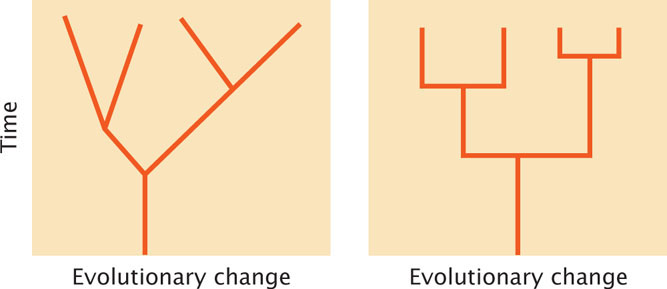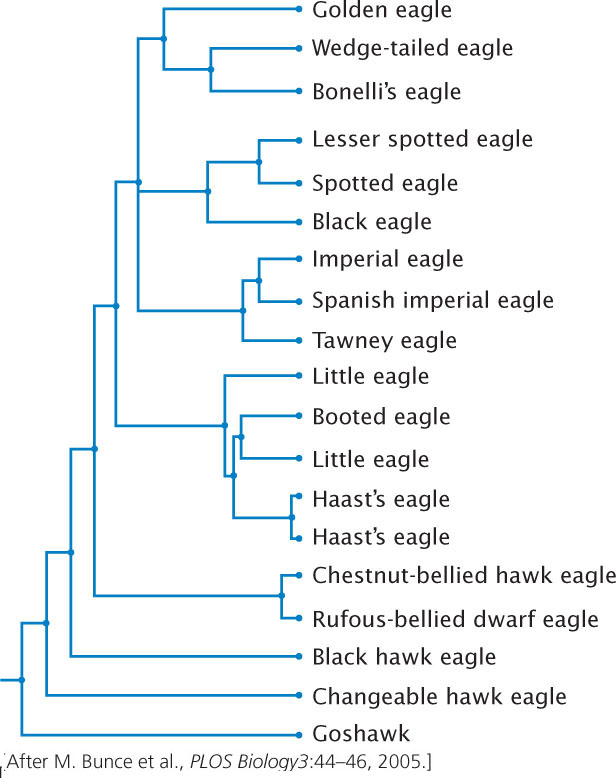Application Questions and Problems
Section 26.1
Question 26.21
The following illustrations represent two different patterns of evolution. Briefly discuss the differences in these two patterns, particularly in regard to the role of cladogenesis in evolutionary change.

Section 26.3
Question 26.22
Which of the isolating mechanisms listed in Table 26.2 have partly evolved between apple and hawthorn host races of Rhagoletis pomonella, the apple maggot fly?
Question 26.23
 We considered the sympatric evolution of reproductive isolating mechanisms in host races of Rhagoletis pomonella, the apple maggot fly. The wasp Diachasma alloeum parasitizes apple maggot flies, laying its eggs on the larvae of the flies. Immature wasps hatch from the eggs and feed on the fly larvae. Research by Andrew Forbes and his colleagues (Forbes et al. 2009. Science 323:776–779) demonstrated that wasps that parasitize apple races of R. pomonella are genetically differentiated from those that parasitize hawthorn races of R. pomonella. They also found that wasps that prey on the apple race of the flies are attracted to odors from apples, whereas wasps that prey on the hawthorn race are attracted to odors from hawthorn fruit. Propose an explanation for how genetic differences might have evolved between the wasps that parasitize the two races of R. pomonella. How might these differences lead to speciation in the wasps?
We considered the sympatric evolution of reproductive isolating mechanisms in host races of Rhagoletis pomonella, the apple maggot fly. The wasp Diachasma alloeum parasitizes apple maggot flies, laying its eggs on the larvae of the flies. Immature wasps hatch from the eggs and feed on the fly larvae. Research by Andrew Forbes and his colleagues (Forbes et al. 2009. Science 323:776–779) demonstrated that wasps that parasitize apple races of R. pomonella are genetically differentiated from those that parasitize hawthorn races of R. pomonella. They also found that wasps that prey on the apple race of the flies are attracted to odors from apples, whereas wasps that prey on the hawthorn race are attracted to odors from hawthorn fruit. Propose an explanation for how genetic differences might have evolved between the wasps that parasitize the two races of R. pomonella. How might these differences lead to speciation in the wasps?
766
Question 26.24
Which of the following in Figure 26.11 is a polyploid?
- a. Spartina maritime.
- b. Spartina alterniflora.
- c. Hybrid between Spartina maritima and Spartina alterniflora.
- d. Spartina anglica.
- e. Both c and d above.
Section 26.4
Question 26.25
How many rooted trees are theoretically possible for a group of seven organisms? How many for 12 organisms?
Question 26.26
Align the sequences below so as to maximize their similarity. What is the minimum number of evolutionary steps that separate these two sequences?
TTGCAAAC
TGAAACTG
Question 26.27
 Michael Bunce and his colleagues in England, Canada, and the United States extracted and sequenced mitochondrial DNA from fossils of Haast’s eagle, a gigantic eagle that was driven to extinction 700 years ago when humans first arrived in New Zealand (m. Bunce et al. 2005. PLOS Biology 3:44–46). Using mitochondrial DNA sequences from living eagles and those from Haast eagle fossils, they created the phylogenetic tree at the right. On this phylogenetic tree, identify (a) all terminal nodes; (b) all internal nodes; (c) one example of a branch; and (d) the outgroup.
Michael Bunce and his colleagues in England, Canada, and the United States extracted and sequenced mitochondrial DNA from fossils of Haast’s eagle, a gigantic eagle that was driven to extinction 700 years ago when humans first arrived in New Zealand (m. Bunce et al. 2005. PLOS Biology 3:44–46). Using mitochondrial DNA sequences from living eagles and those from Haast eagle fossils, they created the phylogenetic tree at the right. On this phylogenetic tree, identify (a) all terminal nodes; (b) all internal nodes; (c) one example of a branch; and (d) the outgroup.
Question 26.28
On the basis of the phylogeny of Darwin’s finches shown in Figure 26.8, predict which two species in each of the following groups will be the most similar genetically.
- a. Camarhynchus parvulus, Camarhynchus psittacula, Camarhynchus pallida
- b. Camarhynchus parvulus, Camarhynchus pallida, Platyspiza crassirostris.
- c. Geospiza difficilis, Geospiza conirostris, Geospiza scandens.
- d. Camarhynchus parvulus, Certhidea fusca, Pinaroloxias inornata.
Section 26.5
Question 26.29
Assume that one of the genes shown in Table 26.4 had similar nonsynonymous and synonymous rates of substitutions. What might this suggest about the evolution of this gene?
Question 26.30
Based on the information provided in Figure 26.15, do introns or 3′ untranslated regions of a gene have higher rates of nucleotide substitution? Explain why.
